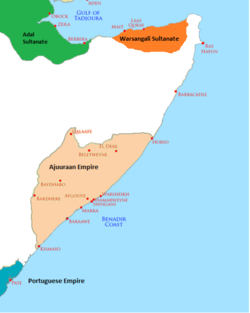Ajuran Empire
| Ajuran Sultanate | ||||||||||
|
Dawladdii Ajuuraan الدولة الأجورانيون |
||||||||||
|
||||||||||
|
Flag
|
||||||||||
|
The Ajuuraan Sultanate in the 15th century
|
||||||||||
| Capital | ||||||||||
| Languages | Somali · Arabic | |||||||||
| Religion | Sunni Islam | |||||||||
| Government | Monarchy | |||||||||
| History | ||||||||||
| • | Established | 13th century | ||||||||
| • | First Ajuran-Portuguese war | 1538–57 | ||||||||
| • | Second Ajuran-Portuguese war | 1580–89 | ||||||||
| • | Oromo invasion | Mid-17th century | ||||||||
| • | Decline | late 17th century | ||||||||
| Currency | Ajuran • Mogadishan | |||||||||
|
||||||||||
| Today part of |
|
|||||||||
The Ajuran Sultanate (Somali: Dawladdii Ajuuraan, Arabic: الدولة الأجورانيون), also spelled Ajuuraan Sultanate, and often simply as Ajuran, was a Somali Muslim sultanate that ruled over large parts of the Horn of Africa in the Middle Ages. Through a strong centralized administration and an aggressive military stance towards invaders, the Ajuran Sultanate successfully resisted an Oromo invasion from the west and a Portuguese incursion from the east during the Gaal Madow and the Ajuran-Portuguese wars. Trading routes dating from the ancient and early medieval periods of Somali maritime enterprise were strengthened or re-established, and foreign trade and commerce in the coastal provinces flourished with ships sailing to and coming from many kingdoms and empires in East Asia, South Asia, Europe, the Near East, North Africa and East Africa.
The sultanate left an extensive architectural legacy, being one of the major medieval Somali powers engaged in castle and fortress building. Many of the ruined fortifications dotting the landscapes of southern Somalia today are attributed to the Ajuran Sultanate's engineers, including a number of the pillar tomb fields, necropolises and ruined cities built in that era. During the Ajuran period, many regions and people in the southern part of the Horn of Africa converted to Islam because of the theocratic nature of the government. The royal family, the House of Garen, expanded its territories and established its hegemonic rule through a skillful combination of warfare, trade linkages and alliances.
...
Wikipedia


